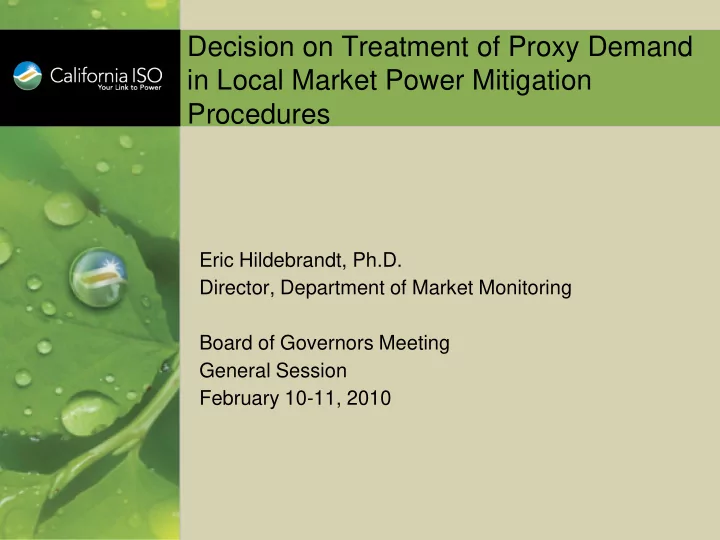

Decision on Treatment of Proxy Demand in Local Market Power Mitigation Procedures Eric Hildebrandt, Ph.D. Director, Department of Market Monitoring Board of Governors Meeting General Session February 10-11, 2010
Proxy demand resource bids may undermine current local market power mitigation process. Mitigating proxy demand resource bids would be problematic. Market bids should reflect cost of curtailing load to end use customers. There is no objective basis for setting an appropriate default energy bid for these resources. Mitigating bids based on default energy bid is likely to be economically inefficient and deter participation. Including proxy demand resource bids in mitigation runs can also displace generation units in this process. Problem can be efficiently solved by excluding proxy demand resource bids from pre-market bid mitigation process. Slide 2
Proxy demand resource bids may displace bids from lower cost generation in current process. Resource Bid Initial Bid Default Final Quantity Price Energy Bid Market (MW) ($/MW) (Cost + 10%) Bid Generation Unit 1 100 $ 100 $ 50 $ 50 Proxy Demand Resource 10 $ 900 -- $ 900 Generation Unit 2 10 $ 950 $100 $ 950 Generation Unit 3 50 $1,000 $200 $1,000 If 110 MW from these resources are projected to be needed for relief of an uncompetitive constraint, only 100 MW bid from Unit 1 would be mitigated. In the actual market run, the proxy demand resource would be dispatched (10 MW) and set LMP at $900. Generation Unit 2 would not be mitigated or dispatched, despite having 10 MW with default energy bid of only $100. Slide 3
Excluding proxy demand resource bids from pre-market mitigation process avoids this scenario. Resource Bid Initial Bid Default Final Quantity Price Energy Bid Market (MW) ($/MW) (Cost + 10%) Bid Generation Unit1 100 $ 100 $ 50 $ 50 Generation Unit 2 10 $ 950 $100 $ 100 Proxy Demand Resource 10 $ 900 -- $ 900 Generation Unit 3 50 $1,000 $200 $1,000 110 MW from Unit 1 and Unit 2 is mitigated to provide 110 MW required under projected demand/supply conditions. Proxy demand resource bids are still used in final market run. If actual market demand or system conditions require additional capacity, proxy demand resource bids still compete with unmitigated bids from unit 3 and would be dispatched. Slide 4
Stakeholders generally supportive of proposed modification. PG&E and SCE strongly support proposal as best short term option. Support alternative bid mitigation approach suggested by DMM in convergence bidding process as better longer term option. ISO determined this approach could not be implemented in conjunction with convergence bidding in 2011. ISO committed to consider this option for implementation in 2012. Slide 5
Only one participant opposes the proposed modification. Energy Connect opposes proposal on grounds it will: Reduce revenues earned by proxy demand resources in constrained areas. Deter development of needed demand response. DMM response in stakeholder process: Proposal maintains proper marginal price signals, while mitigating local market power. High priced proxy demand resources may also rely on other revenue sources (resource adequacy and ancillary services). Any special incentives to promote demand response should be targeted at proxy demand resources and not distort overall market dispatch and prices. Slide 6
Management requests approval of the proposal. Implementation achievable by May 2010. Eliminates problem effectively and efficiently. Allows lower priced proxy demand response to compete in non-competitive areas based on marginal cost of available generation. Higher priced proxy demand response can still compete directly against unmitigated bid prices of generation that may be dispatched under extraordinary conditions. Slide 7
Recommend
More recommend